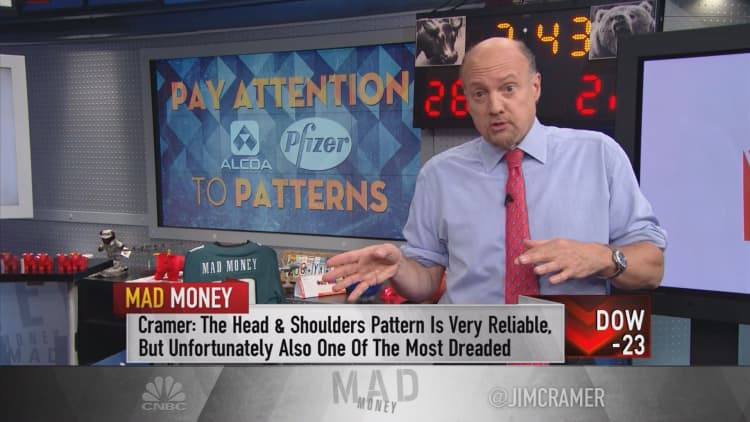
The most simple and reliable chart pattern out there is one that Jim Cramer dreads.
Unfortunately, Cramer learned not to ignore the head-and-shoulders pattern the hard way when his charitable trust boughtAlcoa in the low teens in 2010, and ultimately took a loss because it was a really early buy.
"Yes, just like a human's head. That is the most frightening pattern in the chart book," the "Mad Money" host said.
Alcoa's stock had a healthy run from winter of 2010 until February 2011, rising to $17 from $13. The stock ran to $18 on the eve of its quarterly earnings report, and Cramer thought it was a fine quarter when it reported.
Yes, just like a human's head. That is the most frightening pattern in the chart book.Jim Cramer
Yet, what worried him was that even after an initial positive reaction, the stock dropped. So, a few days later, Cramer assumed it would take out its $18 level and went back to buy more.
Cramer was wrong — extremely wrong.
What Cramer didn't realize is that the fluctuation in price had traced a perfect head-and-shoulders pattern. And no, this isn't referring to the brand of a shampoo.
It turns out that during that period when the head-and-shoulders pattern was forming on Alcoa's chart, Europe and China began to slow down, and aluminum was in a glut. Ultimately, CEO Klaus Kleinfeld could control his own company but not the price of the commodity itself.
Likewise, if a head-and-shoulders pattern signals trouble ahead, then an inverse head-and-shoulders pattern signals the opposite — a chance for glory.
"The key with this pattern is the neckline, the line that connects the high to the two shoulders. When a stock breaks out above that line it tells a technician that you are about to witness a big move higher," Cramer said.
At the end of the day, patterns matter. So when you see a head-and-shoulders pattern, no matter how confident in the stock you might be, Cramer believes you should sell. And when the reverse head-and-shoulders develops, then consider buying it.
That is just how powerful these moves are. The chart work is more often right than most would ever think possible.
Questions for Cramer?
Call Cramer: 1-800-743-CNBC
Want to take a deep dive into Cramer's world? Hit him up!
Mad Money Twitter - Jim Cramer Twitter - Facebook - Instagram - Vine
Questions, comments, suggestions for the "Mad Money" website? madcap@cnbc.com



